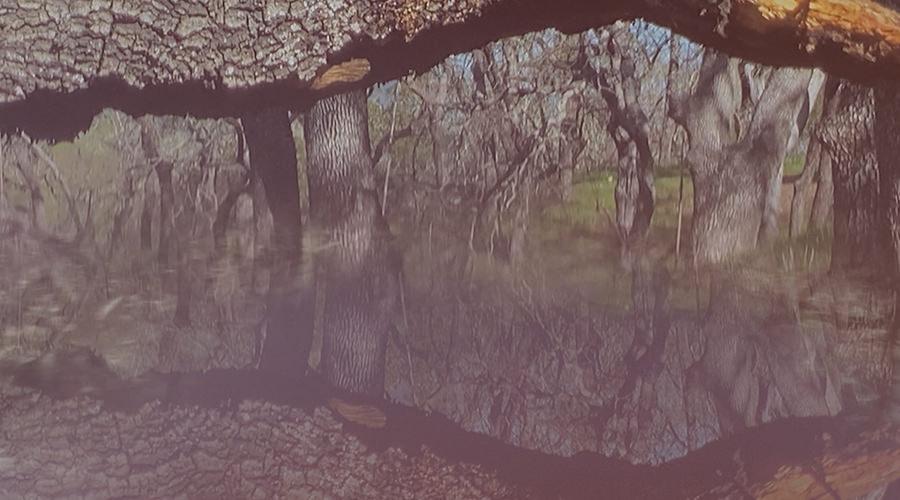CANCELLED: Bienen Contemporary/Early Vocal Ensemble
Árbol de Bocas

Sunday, May 15, 2022 at 9:00pm CDT
Galvin Recital Hall
Donald Nally, conductor; Andrew Major, assistant conductor; ˜Nois Saxophone Quartet; Ben Roidl-Ward, bassoon; Theo Espy, violin; Kyle Flens and Reed Puleo, percussion; Elana Meyers and Jane Bergkotte, art/film
Northwestern Presidential Scholar and Bienen PhD candidate Luis Fernando Amaya’s Árbol de Bocas (“Tree of Mouths”) is a soundscape opera with accompanying film in which the only character is a fantastic tree inhabiting the middle grounds between the animal and vegetal realms. Experience a year in the life of a tree that grows mouths instead of leaves, immersed in the sound world of what this tree perceives through its non-human senses.
Program Note from Composer Luis Fernando Amaya
Scored for twenty-four voices, saxophone quartet, percussion, semi-soloists, and electronics, Árbol de Bocas is a one-hour-long multi-media opera that depicts a year in the life of its only character: a tree. This tree, however, is not a common one; it belongs to an imaginary species that we, humans, can hear—the sole sensory medium through which we cannot experience plants. Aurally, the mixture of the timbres of the live instruments and the electronics creates sonorities that lie somewhere in between the familiar and the unrecognizable—a representation of exploring through non-human senses the world we know. Visually, the audience is immersed in what this tree perceives through its leaves, roots, and bark. The sped-up display of the tree’s ‘tempo’ and the tree’s capacity to produce expressive sounds audible to humans conceptually bridges two physiological gaps that bolster the otherness experienced by humans toward plants. The aural and visual stimuli of the opera represent an exploration of what Michael Marder calls phytophenomenology, the way in which a plant “makes sense of its own world, in its own manner, through its own channels of communication and ways of accessing, processing and acting upon visual, tactile and other types of stimuli.”
The narrative of Árbol de Bocas is decidedly straightforward. By means of accelerating the ‘tempo’ of the Tree’s experience of the world, the audience witnesses one year of its life in sixty-one minutes, including the four seasons and the transitions between them. The opera starts mid-Spring and ends in early Spring of the following year, where the cycle is interrupted by an external force which blinds, deafens, and silences the Tree.
In Árbol de Bocas, I challenge myself with creating a work that explores the world through vegetal senses since plants’ bodies perceive and act on their surroundings differently than those of animals. To bring this artistic and psychological experiment to a point that actively challenges profoundly human world constructions, my collaborators and I have had to delve into the gray areas between the familiar and the strange, and the relatable and the humanly incomprehensible.
Musically, the sounds in Árbol de Bocas strive for a timbral mixture between the instruments as well as with the electronics in such a way that the audience gets the impression of listening to something familiar that, yet, is not quite recognizable as they know it. A visual analogy would be to see sunlight perceived through leaves instead of eyes. To achieve this, I make use of complex textures where various if not all of the parts are layered with microtonally extended unisons. This veils the distinctive qualities of each timbre and creates new ones that, however subtly, allude to their source.
The variety of angles, movements, and speeds of Meyers’ footage provides a compelling match to the opera’s musical element while Bergkotte's digital processing of the footage adds an almost imperceptible yet necessary element of difference. By means of combining experimental cinematography, editing, and digital processing, the non-sonic elements of Árbol de Bocas help to bring the experience of exploring more-than-human subjectivity to a deeper, immersive level.
Mary B. Galvin Recital Hall
Address
70 Arts Circle Drive
Evanston, IL 60208
United States
About
Located in the Ryan Center for the Musical Arts, this 400-seat hall features a 40-foot glass wall offering views of Lake Michigan and the Chicago skyline. Undulating walls of Forest Stewardship Council–certified wood, covered with a thin layer of African moabi wood, provide optimal acoustics, and the hall is equipped with state-of-the-art sound and video equipment for recording.